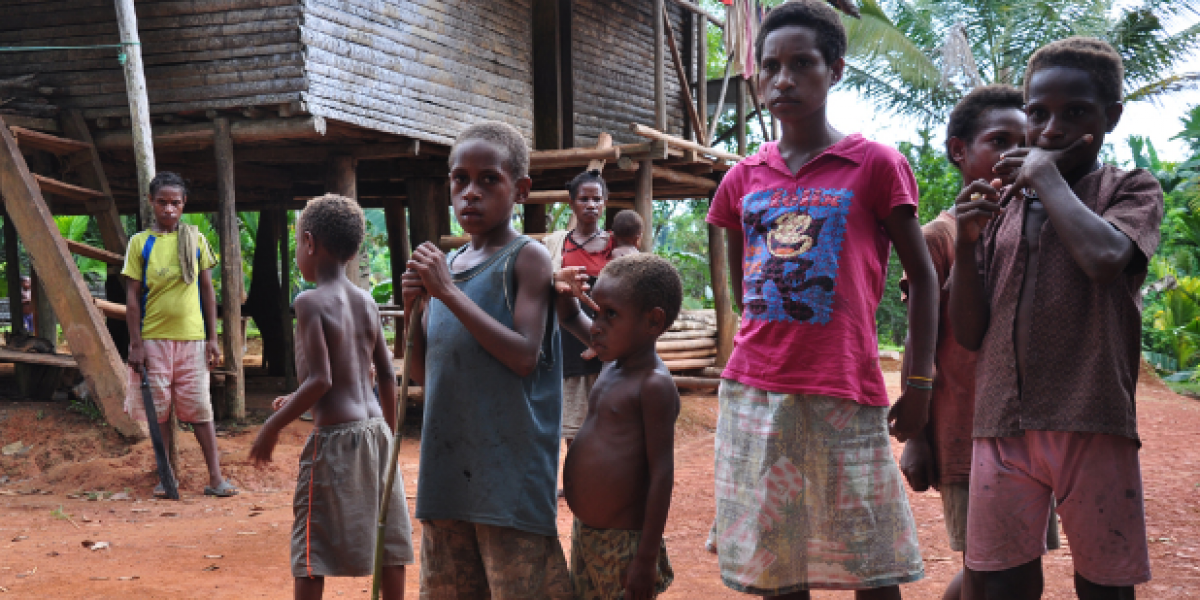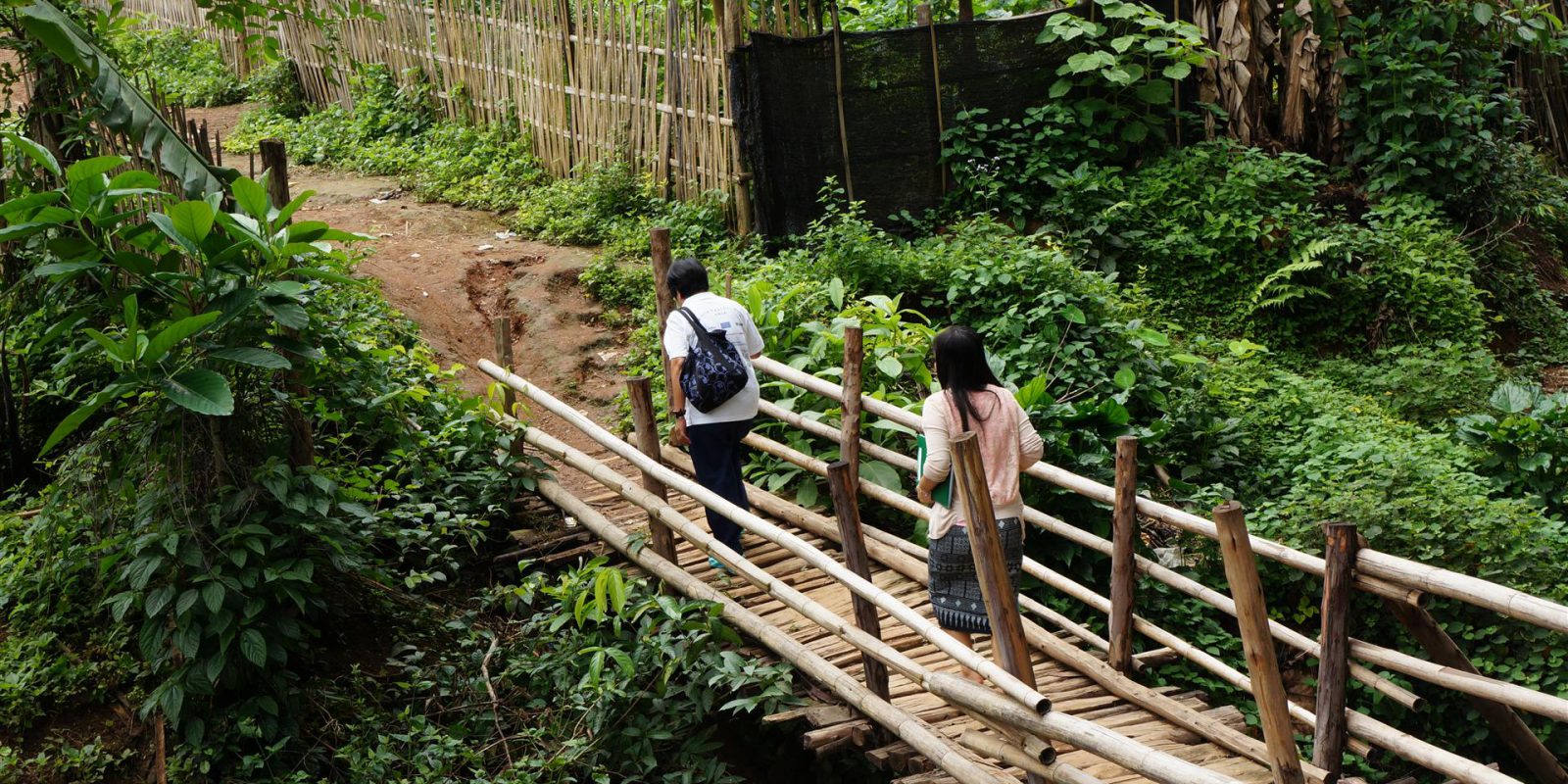Papua New Guinea: The slow tides of change – West Papuan refugees, 25 years of exile
16 March 2011|Wren Chadwick, JRS Information and Advocacy officer in Papua New Guinea

Kiunga, 16 March 2011 – From the banks of the Fly River in the industrial township of Kiunga, I watch Martina standing motionless, perfectly balanced at the front of the dug-out canoe as it glides gracefully towards me. I am struck by her regal appearance as the sun glints off the droplets in her hair – like a queen who has just stepped out of her palace.
In reality Martina has climbed down from her simple house, constructed with bush material, plastic and iron sheets she and her family have collected over the years. Despite being built on long, thin poles, high above the ground, the water has risen to just inches below the floor following heavy rains in the mountains. With an average annual rainfall in the mountains of over eight metres, this is not an uncommon event.
As Martina’s young cousin effortlessly manoeuvres the narrow canoe, I am struck by the resourcefulness of these communities who have elected to build their homes on this ‘unwanted’ land. Martina’s house is set amongst a cluster of about 25 built on the spillway of the Fly River, just off the main road of Kiunga in Papua New Guinea’s Western Province.
With 97 percent of land in the country owned by the indigenous people, and 80 percent of the population relying on the land for their daily needs, there is little land available for purchase (even if you can afford it). So the refugees who come to town to be closer to services and employment opportunities, and settle on what unclaimed land they can find. Martina’s cousin shoots me a cheeky smile before pushing off to return to the games inside her house. With the water high, there are few dry places to play outside.
Causes of displacement
Martina is one of more than 800 West Papuan refugees living in this remote town, her parents having fled across the Indonesian border along with nearly 12,000 others between 1984 and 1986. The group fleeing was diverse and included educated student activists, militant freedom fighters, and subsistence farmers and their families.
Some refugees fled for their lives, having been targeted for punishment for their political activism, others sought refuge from threatened and real violence from both the Indonesian military and the OPM militants, some fled to escape from Indonesia’s oppressive policies which left Papuans feeling like second-class citizens in their own land, others hoped to bring international attention and support to their resistance of Indonesian occupation.
Upon arrival, the asylum seekers established a series of makeshift camps close to the border in both the Western Province along the Fly and Ok Tedi rivers, and in the Northern Sandaun Province. Initially the Papua New Guinea government hoped that they would return of their own accord and even forcefully returned some. But eventually, the poor camp conditions (including the death of around 90 people in one) prompted the government to accept that they were ‘prima facie’ refugees, sign the 1951 UN Refugee Convention and agree to allow the UN refugee agency (UNHCR) and others, including NGOs and the Catholic Church, provide assistance.
More than 25 years on, more than 10,000 West Papuan refugees remain in the country. Approximately 2,500 now live in East Awin, the official camp established by the government in an attempt to move the refugees away from the porous border and placate their Indonesian neighbour.
The 15km tract of land at East Awin site was carved out of the dense jungle about one hour’s canoe ride, and another 2-7 hours by truck or tractor (depending on the road conditions) from Kiunga. Although persistent road problems means accessing markets and other facilities in Kiunga is a problem, these refugees are serviced by aid posts, a health centre, elementary and primary schools, to a standard at least as good as their local neighbours.
Approximately 5,000 refugees refused the government’s instruction to ‘either move to East Awin or return to Indonesia’, preferring to stay near the border areas, close to their traditional land and amongst people with whom they share the same language and culture. Even the removal of all government and UNHCR services has not persuaded them to move.
Today, the Catholic Diocese of Daru-Kiunga is the main provider of basic health and education services to refugees in these areas. Some health services are also provided by the Evangelical Church of Papua New Guinea and Australian Doctors International. While the government does not actively prevent these services being offered in limited forms, some parts of government no longer acknowledge that the refugees remaining near the border are in fact refugees, referring to them instead as ‘border crossers’.
The border refugees, like the locals around them, live a subsistence lifestyle, growing sweet potato, bananas, cassava, peanuts and sago. Unlike many of the locals, however, they do not have access to the regular compensation payments made to communities who live along the rivers polluted by the Ok Tedi mine. While many refugees complain about the unfairness of this arrangement – after all they are living with the daily impact of the pollution – many observers remark on the industriousness of the refugee communities who have not grown dependent on the cash hand-outs from the mine.
In most of the border communities, the refugees belong to the same tribal group as their local hosts; the imposed international boundary is recognised as only secondary to the land boundaries their ancestors fought hard to claim and maintain. Despite these kinship bonds, however, relations with locals are tense in some areas, with the local landowners who initially welcomed them as relatives, feeling that they have now outstayed their welcome. Indeed, in some places, the fast-growing refugee communities now outnumber their local hosts, and more and more land is required to sustain them.
The remaining 2,500 refugees are scattered around cities and towns of Papua New Guinea. Those in Kiunga, have come to be closer to schools, hospitals, markets and employment opportunities. Employment is hard to come by, however, and many in town have little or no access to land for food gardens. Many, like Martina’s family, rely on the small income raised by selling doughnuts, betel-nut, or icy-poles from small tables set up beside the dusty road to pay for food, clothes and school fees.
Providing assistance
The Catholic Church has a long history of providing assistance to refugees in Papua New Guinea. As a major partner in the early relief efforts, it distributed food relief and other basic supplies and was a significant advocate for the humane treatment of refugees by the government.
The Diocese of Daru-Kiunga continues, in partnership with NGOs such as Horizont3000, Mercy Works Inc and more recently the Jesuit Refugee Service (JRS), to advocate with and on behalf of refugees and, through programmes, such as teacher training, maternal health, adult literacy and student sponsorships, to ensure their basic needs are met.
For many years the Diocese had a separate refugee programme and dedicated Parish personnel. Recognising the importance of facilitating local integration, however, the refugees are today integrated into the parish structure along with their neighbours.
Since 2008, JRS has been working in partnership with the Diocese of Daru-Kiunga to provide accurate information to refugees about their rights and options for the future, to strengthen the Diocese’s capacity to advocate for refugees, and with the Bishop, to advocate for the rights and needs of refugees at national and international levels.
To this end, JRS Information and Advocacy Officers have visited the remote refugee settlements up and down the border to collect information, conducted training with Diocesan personnel, published newsletters for refugees, and worked with UNHCR and all levels of government to identify and address issues of concern to refugees.
The future for West Papuan refugees
The tables turn slowly in Papua New Guinea, however, and positive change can be a long time coming. What is the durable solution to this protracted refugee situation? Generally, in refugee situations, voluntary repatriation is the preferred option, where possible. A number of refugees have indeed returned to West Papua on Indonesian-sponsored aircraft in repatriation exercises organised by the Indonesian and the Papua New Guinea government.
Indonesia promotes voluntary returns, hoping to show to the international community that West Papuans have no reason to seek asylum. UNHCR is not yet satisfied that the conditions necessary for voluntary return exist, so has not supported such exercises. With outside journalists and human rights organisations prevented from entering West Papua, it is difficult to know how these returnees fare.
For the majority of West Papuan refugees, return is not something they will do voluntarily, at least not until they achieve their political aspiration of an independent nation. For these refugees, local integration is the most likely durable solution. Indeed, after more than 24 years, this integration is well underway.
As the Bishop of Daru-Kiunga puts it “the gradual, silent Melanesian-style process of integration through power-struggles, exchanges, alliances and inter-marriage is already taking place”. Local integration is not without its challenges, however. Permanent, regularised access to land, for instance, is a major issue of concern for both refugees and their host communities, with no easy solution.
Access to citizenship is another obstacle to overcome, albeit with a more straight-forward solution. Despite fulfilling the residency requirement for citizenship, the current fee of K10,000 (AU$4,500) is prohibitive for all but the most fortunate refugee. Additionally, border refugees are currently not eligible given their status has not been regularised.
These factors along with the operation of Indonesian law have left most refugees, including their children who were born in Papua New Guinea, stateless. One refugee said “if they can’t give me citizenship, I’m ok with that because I’m already old, but at least give my children a country to belong to”. Other refugees only want to be a citizen of a free West Papua.
Although resource-rich (Western Province is home to the Ok Tedi gold and copper mine which generates significant income for the country), the dispersed population, lack of service infrastructure and difficult-to-access rural population creates many obstacles to service provision and economic development for its residents. Consequently, the Western Province has some of the highest rates of poverty, and performs among the lowest in terms of health and education statistics.
Along with many refugees and locals, Martina is one of the 40% of year 10 students who did not get high enough grades to obtain one of the limited number of places in year 11. For these young people, opportunities are limited. Martina is not deterred, however. She is taking any opportunity she can – attending JRS journalism sessions to produce content for the JRS newsletter and improve her English skills has inspired her try to upgrade her school marks by correspondence, and hopes to secure a place at a teachers’ college.


